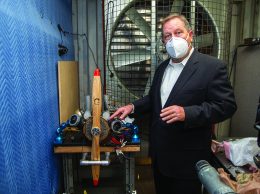MIT forum in Santa Barbara focuses on remote healthcare technology
IN THIS ARTICLE
- Health Care & Life Science Topic
- pacbiztimes Author
By pacbiztimes Thursday, May 21st, 2015
A white, rolling 5-foot robot mounted with an LCD screen roamed around the Cabrillo Arts Pavilion Wednesday night. While it’s not a typical sight at the pavilion, it’s a growing presence in the healthcare industry.
Yulun Wang, the founder and CEO of Goleta-based telehealth firm InTouch Health, used the robot, called RP-VITA, to demonstrate how cloud-based technology allows physicians to interact with and diagnose patients from miles away. He led a discussion on how remote technology is changing the healthcare industry at the Central Coast MIT Forum Wednesday night.
InTouch Health created the Remote Presence robot, which drives itself using infrared cameras and receivers, is equipped with a camera, phone, ultrasound and other medical-device ports, and a stethoscope. It also projects the physician’s face or beams test results through its LCD screen. RP-VITA reduces healthcare costs and saves precious seconds in emergency situations,eliminating the time and distance barriers that have traditionally cut off hospital patients from proper care by combining cloud-based technology and robotics. It is being used in 1,200 hospitals around the country, Wang said.
“We have a doctor in Montana who takes care of patients in 50 hospitals thousands of miles away,” he said. “They’re oftentimes plugging gaps where the local hospital is unable to fulfill its
resource needs.”
The technology has had a major impact on stroke victims, who can lose countless brain cells every minute care is delayed. Stroke is the third-leading cause of death and it leads to the most disabilities, but only 2 to 8 percent of patients are treated properly, Wang said. The robot is also used in mental health, critical care, pediatrics, trauma, organ donation and many other applications and plans to perform about 150,000 consultations this year, Wang said.
“It’s possible that virtual care can become better than in-person care,” he said. Aside from RP-VITA, more hospitals are sending patients home with tablets and devices that patients use to send their vital information via the cloud and doctors can monitor their progress — vastly reducing hospital visits. It also saves money by automating data collection. Panelist Rita Moya, a chief strategist at Santa Barbara-based health improvement technology firm BioIQ, said convenience is a major factor.
“The selling point of telehealth is the convenience to the consumer,” she said.
While the technology makes healthcare delivery more efficient and convenient, there are barriers when it comes to payment and fear of change, Moya said. Health care has traditionally been a fee-for-service business, but now that’s shifting to a value-delivered model, Wang said.
“Providers have to get over the concern that they’re going to get left by the wayside,” said panelist Melinda Staveley, the vice president of Cottage Rehabilitation Hospital.
Still, technology can only do so much when it comes to changing human behavior, Wang said.
“That’s what healthcare providers are trying to do, incentivizing people to stay healthy,” he said.











